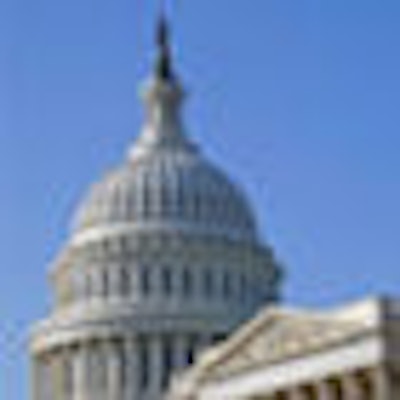
Advocates for medical imaging are lobbying against a recommendation by the Medicare Payment Advisory Commission (MedPAC) that could add another 40% cut to payments for the technical component of imaging exams.
In a report issued to Congress earlier this month, MedPAC board members recommended that the U.S. Centers for Medicare and Medicaid Services (CMS) change the formula that determines physician reimbursement rates for advanced imaging procedures to put the lid on imaging costs.
Currently, the CMS formula for calculating the relative value units (RVUs) that determine reimbursement rates assumes that imaging facilities operate equipment 25 hours a week, or 50% of the time they're open for business. This calculation has led to higher payments for imaging services, according to a MedPAC report issued on March 17.
"Once providers purchase machines, they have an incentive to use them as frequently as possible," the report states. "Indeed, there is evidence that MRI and computed tomography (CT) machines are used much more frequently than Medicare assumes."
Instead, MedPAC is proposing that CMS adopt a standard in which imaging equipment is used at close to full capacity -- 45 hours a week, or 90% of the time. The change would apply to all diagnostic imaging units that cost more than $1 million -- and CMS should examine applying it to cheaper scanners as well, MedPAC recommends.
The change could cut technical payments for MRI, CT, and PET from the Medicare Physician Fee Schedule by as much as 40%, although, when combined with payment cuts already implemented by the Deficit Reduction Act of 2005, the impact on imaging practices might be closer to 20%.
The report goes on to state that Medicare's allegedly high reimbursement rates for imaging services have helped fuel the boom in procedure volume that has occurred recently.
"The rapid volume growth of costly imaging services may be driven, at least in part, by prices that are too high," the report said. "Higher payments encourage providers with low expected volumes to purchase expensive imaging machines."
Crude tool
But industry watchers criticized MedPAC's recommendation, describing it as too crude a tool for something that is incredibly complex.
"Of many things being considered [by the government] for how to get control over healthcare costs, imaging is a target," said Tom Greeson, a partner at Reed Smith of Falls Church, VA, who specializes in radiology-related regulatory matters. "But the obvious question is: What's the best policy for making changes? The concern about this MedPAC recommendation is that it's a crude way of trying to deal with overutilization, rather than a tailored response to the problem. It's the worst way of dealing with costs, since it cuts reimbursement for both appropriate and inappropriate studies."
And not only is MedPAC's recommendation crude, it's based on insufficient data, according to Pam Kassing, senior director of health economics and policy at the American College of Radiology (ACR) in Reston, VA. To gather data for the recommendation, MedPAC only surveyed six imaging centers in six different regions of the country.
"Medicare has been trying to find a correct percentage for this formula for a while," Kassing said. "They've said they're not willing to change the percentage until they have data that show which percentage is correct, and we support that. We don't find that MedPAC's data are representative of imaging across the country, especially in rural areas, and not of imaging in general, because they only surveyed for CT and MR."
The ACR has been active in a survey that the American Medical Association (AMA) has conducted on practice cost and equipment utilization, Kassing said; data from this survey should be available soon.
"We know the formula, and [along with the AMA] we're looking at it in its entirety, not just this one piece," she said. "We don't think that MedPAC's dataset is the one that should be used to make changes."
It's important to educate CMS, MedPAC, and Congress, according to Paul Viviano, chair of the Association for Quality Imaging (AQI) in Washington, DC.
"We've done a lot to educate CMS, and we made an educational effort with MedPAC board members, because the real fight on this issue is a congressional one," Viviano said. If Congress wants to look at the reimbursement formula for imaging, we're for that, but that process should include evaluating not only equipment utilization assumptions, but everything, like interest rates and the cost of the equipment."
The government needs to know that although making cuts to imaging payments seems like an effective way to deal with overspending, it isn't necessarily, Greeson said.
"I hope CMS and other policymakers will think about the systemic cause of imaging overuse and deal with that in an appropriate manner, rather than taking out the meat axe," he said.
CMS issues its proposed rule for the Medicare Physician Fee Schedule in the summer and, after taking comments, its final rule in the fall, Kassing said. Until then, medical imaging advocates will watch and wait.
"We don't have anything concrete to comment on until CMS puts out its proposed rule," Kassing said. "And despite the fact that, with this recommendation, MedPAC is making it clear that it really wants Medicare to move forward and address the physician fee formula, the agency may not even take up the issue. But if it does, we will certainly respond."
By Kate Madden Yee
AuntMinnie.com staff writer
March 26, 2009
Related Reading
AMIC criticizes MedPAC report, February 26, 2009
Medical imaging hopes to cut losses in Medicare reform debate, January 27, 2009
Beware, AMIC says: The DRA could be the least of it, June 10, 2008
Copyright © 2009 AuntMinnie.com



















